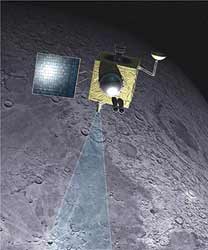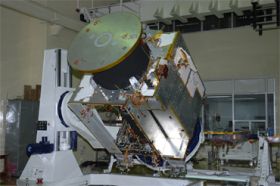Swedish, German and the UK’s payloads aboard Chandrayaan-1
22 Oct 2008
Chandrayaan-1 has become a beacon of scientific collaborations between space agencies worldwide, with six of the 11 payloads it is carrying having been developed in collaboration with the European Space Agency (ESA), NASA, Bulgaria, Sweden, and Germany. Chandrayaan-1 as a mission will focus on high-resolution remote sensing of the lunar surface in visible, near-infrared, X-ray and low energy gamma rays.
The Swedish experiment - SARA One of the payloads the lunar mission is carrying is the particle instrument SARA (Sub-Kev Reflection Atom Analyzer), which has been co-developed by the Swedish Institute of Space Physics (IRF) at Kiruna, Sweden, and the Space Physics Laboratory of the Vikram Sarabhai Space Center (SPL-VSSC), at Thiruvananthapuram, India.
One of the payloads the lunar mission is carrying is the particle instrument SARA (Sub-Kev Reflection Atom Analyzer), which has been co-developed by the Swedish Institute of Space Physics (IRF) at Kiruna, Sweden, and the Space Physics Laboratory of the Vikram Sarabhai Space Center (SPL-VSSC), at Thiruvananthapuram, India.
The project has contributions from the University of Bern, Switzerland, and the Institute of Space and Astronautical Science of the Japan Aerospace Exploration Agency (JAXA), Sagamihara, Japan.
The SARA experiment is also the first collaborative project between Kiruna – based IRF and ISRO. This instrument will study the surface composition of the moon, the way the moon's surface reacts with solar winds and the magnetic anomalies associated with the surface of the moon.
SARA will perform remote sensing of atoms kicked up off the outermost layer of the lunar surface by the solar wind. As the Moon lacks an atmosphere, the solar wind, which is basically a stream of charged particles from the Sun, impacts the Moon surface constantly.
SARA will study how the solar wind interacts with the Moon surface. It will address important issues for future Moon exploration, and will shed light on the composition of the Moon's, mapping how the lunar surface changes under the influence of the solar wind.
Eight members of the SARA team attended the launch of Chandrayaan-1 in India. They include a scientist and six engineers from IRF, the project experiment manager, and a scientist from JAXA in Japan.
German spectrometer flies to the Moon  Chandrayaan-1 is also carrying the German science and technology contribution comprising an infrared spectrometer (SIR-2) designed and built by the Max Planck Institute for Solar System Research (MPS) in Katlenburg-Lindau.
Chandrayaan-1 is also carrying the German science and technology contribution comprising an infrared spectrometer (SIR-2) designed and built by the Max Planck Institute for Solar System Research (MPS) in Katlenburg-Lindau.
The SIR-2 spectrometer has a key role to play in the production of the first high-resolution global mineralogical map of the Moon. Drawing from the low circular orbit of the moon that Chandrayaan-1 will follow for its two year mission, the infrared spectrometer SIR-2 from Max Planck Institute for Solar System Research (MPS) will help map the main mineralogical components of the lunar surface, with unprecedented reliability and resolution.
The Moon and the Earth have a shared history, both having their cosmic origins dating back around 4.5 billion years. Though evidence of these prehistoric times is hard to come by on Earth on account of tectonics, weather and life, the Moon is said to have preserved these signs in its geological and mineralogical composition.
However, lunar missions in the past have been able to study only selected parts of the Moon's surface, as those missions were limited in time and instrumentation, or had an elliptical orbit that in part carried the space probe far away from the Moon.
Chandrayyan-1 will orbit the Moon for two years, in a low circular orbit of 100 kilometres above the lunar surface. Moreover, it has a full compliment of several new and advanced scientific instruments.
The SIR-2 uses the optical properties of mineral components within lunar soils. Similar to a leaf which absorbs all colours of the spectrum except green, minerals absorb specific wavelengths of sunlight that are not reflected back into space.
In order to find these gaps, the SIR-2 splits the reflected lunar light into is components, similar to a prism resolving sunlight into the colours of the rainbow. The missing wavelengths indicate the mineralogical composition of the Moon's surface.
As most of the characteristic 'colours' of the main minerals found across the solar system lie beyond red in the longer wavelengths called infrared, SIR-2 is infra-red optimized to work with these wavelengths. It is a product of an on-going research and application programme at MPS that aims to develop and produce a state-of-the-art and sophisticated range of spectrometers operating in the visible to near infrared.
SIR-2 was developed through funding provided by the Max Planck Society and the ESA.
Wales takes an x-ray peek into the Moon's history
There is also a payload aboard Chandrayaan-1 that owes its origins to a little corner of Wales. Experts from the Aberystwyth University have contributed a sophisticated X-ray camera called the C1XS that was designed and built at the STFC Space Science and Technology Department in the Rutherford Appleton Laboratory at Didcot, Oxfordshire.
Using the C1XS, scientists want to map the surface composition of the Moon by measuring data provided by the X-rays, in order to better understand the Moon's origins and evolution.
The C1XS will let scientists see the Moon in a new was that will describe what it is made of, over the whole surface, shedding new light on the mysteries about the origin of the Earth-Moon system.
The camera utilises new technology that makes it a compact, lightweight and sensitive enough to allow it to measure the abundance of chemical elements in the lunar surface.
Professor Manuel Grande, who heads the Solar Systems Physics Group at the Institute of Mathematics and Physics at Aberystwyth said that while the Apollo missions had taken valuable samples of the moon's surface, they were from an area that was safe for astronauts to land. He says that even though it told us ''a fantastic amount'', it can best be described as ''taking samples from the desert and trying to use that to work out everything about the Earth's surface."
The C1XS builds on technology that has been used by the European Space Agency, called D-CIXS, on the Smart-1 mission to the Moon. The camera will provide important information to help produce accurate maps of the surface composition of the moon, and help unravel secrets about its internal structure and geological history. These maps would subsequently be valuable in finding the best places to look for natural resources on the Moon.






















